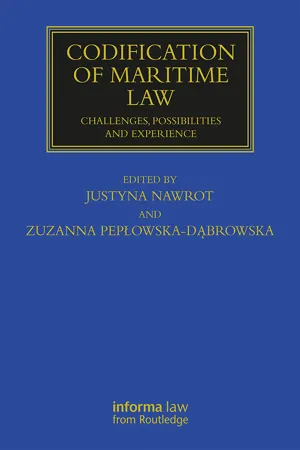
Codification of Maritime Law
Challenges, Possibilities and Experience
- 264 pages
- English
- ePUB (mobile friendly)
- Available on iOS & Android
Codification of Maritime Law
Challenges, Possibilities and Experience
About this book
This book is the first of its kind to explore the problems inherent in the unification of maritime law. Featuring contributions from leading experts at European maritime law research centres, it considers international conventions, current maritime practice, standard forms and recently adopted or drafted national codifications of maritime law from the codification point of view.
The book is divided into four parts which represent different views on the main topic. Part I gathers chapters dedicated to different aspects and methods of unification of maritime law on a global scale, as well as several specific issues of maritime law from the regulatory point of view. Part II of the book consists of those papers that centre around the issue of transport of goods. Part III is dedicated to codifications of carriage of passengers, cruise law and leisure navigation. Finally, Part IV addresses national codifications of maritime law.
Codification of Maritime Law: Challenges, Possibilities and Experience seeks to provide common ground for future unification of maritime law, which makes the book useful both for private and public maritime lawyers and states' maritime administrations worldwide.
Frequently asked questions
- Essential is ideal for learners and professionals who enjoy exploring a wide range of subjects. Access the Essential Library with 800,000+ trusted titles and best-sellers across business, personal growth, and the humanities. Includes unlimited reading time and Standard Read Aloud voice.
- Complete: Perfect for advanced learners and researchers needing full, unrestricted access. Unlock 1.4M+ books across hundreds of subjects, including academic and specialized titles. The Complete Plan also includes advanced features like Premium Read Aloud and Research Assistant.
Please note we cannot support devices running on iOS 13 and Android 7 or earlier. Learn more about using the app.
Information
PART I
GENERAL REMARKS
CHAPTER 1
Codification
1 Introduction
2 Codification of private law in general
Table of contents
- Cover
- Half Title
- Series Page
- Title
- Copyright
- Table of Contents
- Foreword
- Preface
- Notes on contributors
- Table of cases
- Table of legislation
- PART I GENERAL REMARKS
- PART II CODIFICATION ISSUES IN TRANSPORT OF GOODS BY SEA
- PART III CODIFICATION IN THE AREA OF CARRIAGE OF PASSENGERS AND LEISURE NAVIGATION
- PART IV NATIONAL CODIFICATIONS OF MARITIME LAW
- Index